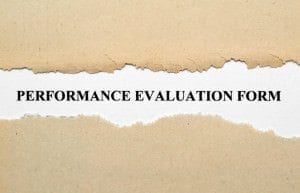Create an Evaluation Form
An employee evaluation form is an extremely effective tool in helping both employees and supervisors recognize an employee’s areas of strength and weakness. A good evaluation form provides plenty of space for supervisor comments and suggestions and will include an easily understandable rating system. When you create an evaluation form, they can be as simple or complex as you would like. The length of your company’s evaluation form will depend on the type of work performed by employees and the complexity of their tasks.
Create an Evaluation Form: Basics
 Begin to create an evaluation form by typing sections for the employee’s name, department, date of hire, date of the current review, date of the previous review and supervisor’s name. Make blank lines after each heading long enough to accommodate long or hyphenated names.
Begin to create an evaluation form by typing sections for the employee’s name, department, date of hire, date of the current review, date of the previous review and supervisor’s name. Make blank lines after each heading long enough to accommodate long or hyphenated names.
Include a description of the numerical rating system to be used when you create an evaluation form. For example, you may decide to use the number one for an unsatisfactory rating, a two to indicate that improvement is needed, a three for satisfactory progress, a four for exceeding expectations and a five for superior work.
Create an Evaluation Form: Categories and Sections
Start an evaluation section for a general assessment of the employee’s skills. Include such categories as attendance, team effort, adherence to procedures, communication skills with coworkers and the public, initiative and work ethic. Include a space to write the rating number for each category, and allow several blank lines for comments after each category.
Add a section for skills that may be specific to your industry. If you work in a factory, you will want to include sections that examine such things as the employee’s skill at operating machinery, output and efficiency. If your employees are sales representatives, you will need to include a section rating the ability to meet quotas and bring in new business.
Create a separate section for evaluation of management skills, if applicable. Include spaces for organization, planning, delegation and meeting goals.
Include sections for the evaluation of the employee’s weaknesses and strengths. Follow this section with an overall rating and an area on setting goals for the upcoming year.
Write a paragraph that says that the review has been discussed with the employee and that the employee’s signature indicates only that he has been presented with the review and does not necessarily mean that he agrees with the review. Include several blank lines for the employee to make any comments.
Provide signature lines for the employee and supervisor. Include a space for the date for each line.
